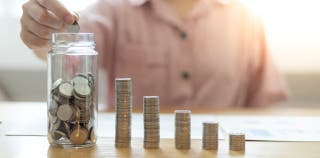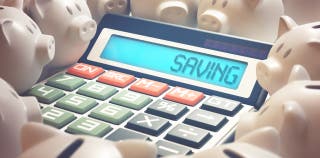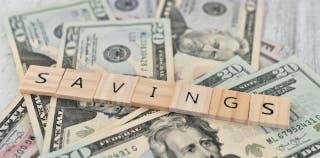What is a high-yield savings account?
A high-yield account pays above-average interest earnings. As of February 2024, the average interest rate for savings accounts was 0.46%, according to the FDIC. Some of the best high-yield savings accounts offer APYs of 4% or higher as of February 2024.
Pros and cons of high-yield savings accounts
Here’s a quick look at the pros and cons of high-yield savings accounts. We’ll explore each of these benefits or disadvantages more in the sections below.
Get to know some of the following high-yield savings accounts:
Pros of high-yield savings accounts: What are the benefits?
High-yield savings accounts come with plenty of benefits, especially when compared to traditional savings accounts.
Earn a higher interest rate
The APY on high-yield savings accounts is higher than it is with traditional banking accounts—often many times higher. Some high-yield savings accounts earn as much as 5% APY.
Interest compounds daily
Most banks offering these accounts compound interest daily and credit it to your account once a month. Daily compounding leads to more savings when you hold balances in your account over a long period of time.
FDIC insurance
Savings accounts at FDIC member banks are covered by deposit insurance. That means you’re protected for up to $250,000 in deposits per account per person. This creates safety for your investment.
Your investment risk is low
On top of the fact that your deposits are protected by federal insurance, you have a guaranteed return. While APY percentages might vary over time, these high-yield savings accounts do always yield something.
Potentially low costs
To remain competitive in the market, many banks offer high-yield savings accounts with relatively few — or even no — fees. This is especially true with online banks, which don’t have overhead expenses associated with managing local branches. They can pass on those savings to account holders by cutting fees.
Easy to access your funds
With a savings account, you don’t run into the liquidity issues you might have with other investments, such as certificates of deposit. You can access your funds anytime, but you might have to pay withdrawal fees if you surpass the limits set on your account.
Easy online access
Most banks offer online account management tools for savings accounts — and certainly, that’s the case if you choose an online-only bank. This can provide peace of mind as you can check your account anytime. It also supports convenience because you can manage deposits, withdrawals and transfers right from your smartphone.
Low barrier of entry
Most high-yield savings accounts don’t have a minimum opening deposit requirement. This lets you get started with savings with any amount.
Cons of high-yield savings accounts: What are the drawbacks?
Of course, you need to weigh the potential disadvantages of a high-yield savings account with the pros before you make a decision.
You might be missing out on a higher return
These types of savings accounts do not offer the highest possible return, even among low-risk bank-related investments. You may be able to earn more money with a certificate of deposit, for example. It’s worth reviewing all your options before you open an account.
Variable interest rates
Banks typically note that the APY is variable, which means it can fluctuate over time. That means the amount you earn on your investment can drop below the inflation rate. If your only goal is to earn interest on your funds, these types of accounts aren’t the best long-term option.
Limited withdrawals
In the past, there was a regulation that required banks to limit the number of withdrawals someone could make from these types of savings accounts within a certain period of time. While that’s no longer the case, many banks still apply thresholds. You might be limited to a certain number of withdrawals each month or a maximum dollar amount before you pay extra to access your funds.
No ATM cards
While a few banks do offer ATM cards for their high-yield savings accounts, most do not. So, you can’t typically get immediate access to your cash.
Some banks charge fees
Some banks charge monthly maintenance fees for these accounts, which can limit or even wipe out your actual earnings. Some also have minimum balance requirements, requiring you to keep an average balance of thousands of dollars to avoid monthly fees.
No physical bank locations
Many high-yield savings accounts are offered by online banks. You would not have access to a local branch where you can get face-to-face help managing your account — or make withdrawals for fast access to cash.
Are high-yield savings accounts safe?
Yes, high-yield savings accounts are generally considered to be very safe — or low-risk — investments. There really aren’t a lot of risks with high-yield savings accounts, especially if your funds are FDIC-insured. You are very unlikely to lose your money in this case.
However, the rate of interest you earn can fall under the inflation rate. That can mean you’re not really earning anything when you account for buying power. You also need to keep your balance lower than the FDIC insurance threshold of $250,000 per account per person for it to be covered.
How can I tell if a high-yield savings account is safe?
Make sure the bank is an FDIC member. You might also want to read customer reviews to ensure the bank offers the level of service you desire.
Should I get a high-yield savings account?
If you’re planning to open a savings account, there usually isn’t a reason not to opt for a high-yield version. If, however, you prefer to bank locally and don’t want to manage your account online or via mobile apps, you might choose to forgo the higher APY for in-person service.
What to consider when choosing a high-yield savings account
When you’re shopping for a high-yield savings account, consider the following factors:
How to open a high-yield savings account
To open a high-yield savings account online, follow these steps:
- Research accounts and find the best savings account option for you.
- Complete the online application with the bank.
- Provide your full name, a valid residential address, contact information and your Social Security or tax ID number.
- Upload proof of identification, which typically requires at least a government-issued photo ID.
- Fund the account, which you can usually do with an electronic funds transfer from an external checking or savings account.
Alternatives to high-yield savings accounts
While the pros of high-yield savings accounts tend to outweigh the cons, you might find a banking option that works better for your goals.
Some alternatives include:
-
Checking accounts. While there are two checking accounts that earn more than 7% interest, you typically won’t earn as much interest when you keep your funds in a checking account. Many traditional checking accounts don’t pay any interest at all, and even high-yield checking accounts don’t tend to offer APYs as high as the best high-yield savings accounts do. However, you get more flexibility and convenient access to your funds via check-writing capabilities and debit cards which can be beneficial for business checking accounts.
-
Certificates of deposit (CDs). Some banks offer CDs with higher APYs. In exchange for the higher yield, you lose any flexibility a savings account offers. You don’t have immediate access to funds, as you typically have to wait for the CD to mature to earn out the rate.
-
Money market accounts (MMAs). Money market accounts offer benefits associated with checking and high-yield savings. You can get higher APYs than you would with traditional checking accounts while maintaining check-writing capabilities.
-
Bonds. Savings bonds are another low-risk investment option with a guaranteed return. As with CDs, however, they are not as liquid as savings accounts, and your investment might be tied up until a maturity date.




































